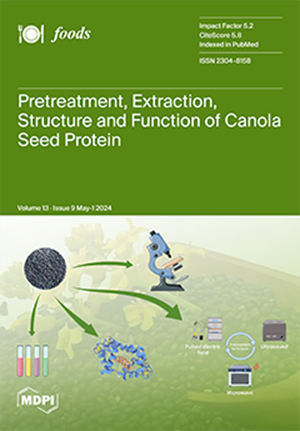Enhancement of Mechanical Properties of Zein-Based Nanofibers by Incorporation of Millet Gliadin
IF 4.7
2区 农林科学
Q1 FOOD SCIENCE & TECHNOLOGY
引用次数: 0
Abstract
In this work, a novel reinforcing filler, millet gliadin (MG), was used for the improvement of the mechanical properties of zein nanofibers. The structural and physicochemical properties of MG were compared with those of zein, and the influence of MG on the morphology, physical properties, and molecular structure of zein nanofibers was investigated. The results indicated that MG has an obviously smaller weight-average molecular weight (7623) in comparison to zein (13,330). Transmission electron microscopy showed that zein molecules more easily form aggregates with larger diameters than MG molecules in acetic acid. At a concentration of 30% (w/v), MG exhibited a significantly higher viscosity (0.66 ± 0.03 Pa·s) than zein (0.32 ± 0.01 Pa·s), indicating the stronger interactions of MG molecules. With the incorporation of MG, the tensile strength was significantly increased to 49.32 MPa (ZM-1/2), which is 2.08 times and 4.45 times higher than that of pure zein nanofibers (ZM-1/0) and MG nanofibers (ZM-0/1-1), respectively. Moreover, zein/MG composite nanofibers exhibited improved water stability. Fourier transform infrared spectra showed evidence of the hydrogen bonding interaction between zein and MG. Therefore, MG is a good candidate for use as a natural reinforcing filler in electrospun nanofibers made of biopolymers.通过加入小米胶蛋白提高玉米蛋白纳米纤维的机械性能
本研究采用一种新型增强填料--小米胶蛋白(MG)来改善玉米蛋白纳米纤维的机械性能。比较了 MG 与玉米蛋白的结构和理化性质,并研究了 MG 对玉米蛋白纳米纤维的形态、物理性质和分子结构的影响。结果表明,MG 的平均分子量(7623)明显小于玉米蛋白(13330)。透射电子显微镜显示,在醋酸中,玉米蛋白分子比 MG 分子更容易形成直径更大的聚集体。在浓度为 30% (w/v) 时,MG 的粘度(0.66 ± 0.03 Pa-s)明显高于玉米蛋白(0.32 ± 0.01 Pa-s),这表明 MG 分子的相互作用更强。加入 MG 后,拉伸强度显著提高,达到 49.32 MPa(ZM-1/2),分别是纯玉米蛋白纳米纤维(ZM-1/0)和 MG 纳米纤维(ZM-0/1-1)的 2.08 倍和 4.45 倍。此外,玉米蛋白/MG 复合纳米纤维还具有更好的水稳定性。傅立叶变换红外光谱显示,玉米蛋白和 MG 之间存在氢键相互作用。因此,MG 是生物聚合物电纺纳米纤维中天然增强填料的理想候选材料。
本文章由计算机程序翻译,如有差异,请以英文原文为准。
求助全文
约1分钟内获得全文
求助全文
来源期刊

Foods
Immunology and Microbiology-Microbiology
CiteScore
7.40
自引率
15.40%
发文量
3516
审稿时长
15.83 days
期刊介绍:
Foods (ISSN 2304-8158) is an international, peer-reviewed scientific open access journal which provides an advanced forum for studies related to all aspects of food research. It publishes reviews, regular research papers and short communications. Our aim is to encourage scientists, researchers, and other food professionals to publish their experimental and theoretical results in as much detail as possible or share their knowledge with as much readers unlimitedly as possible. There is no restriction on the length of the papers. The full experimental details must be provided so that the results can be reproduced. There are, in addition, unique features of this journal:
manuscripts regarding research proposals and research ideas will be particularly welcomed
electronic files or software regarding the full details of the calculation and experimental procedure, if unable to be published in a normal way, can be deposited as supplementary material
we also accept manuscripts communicating to a broader audience with regard to research projects financed with public funds
 求助内容:
求助内容: 应助结果提醒方式:
应助结果提醒方式:


